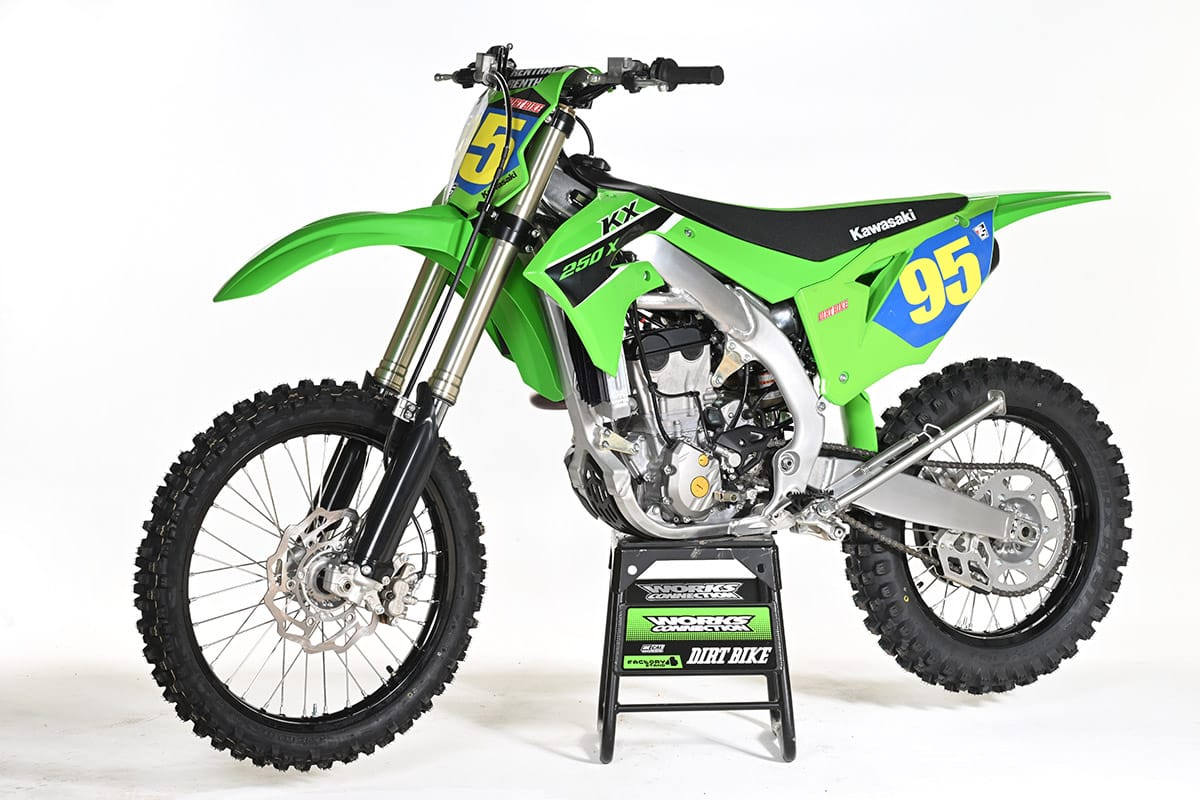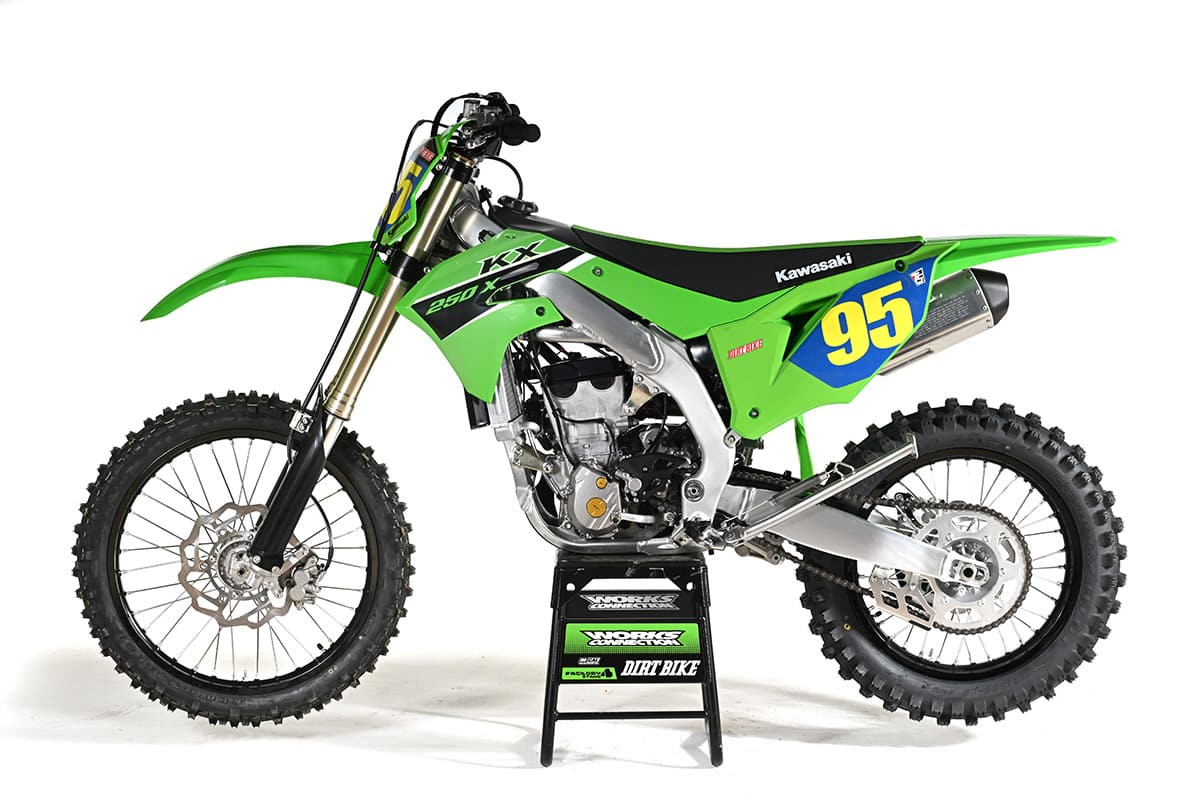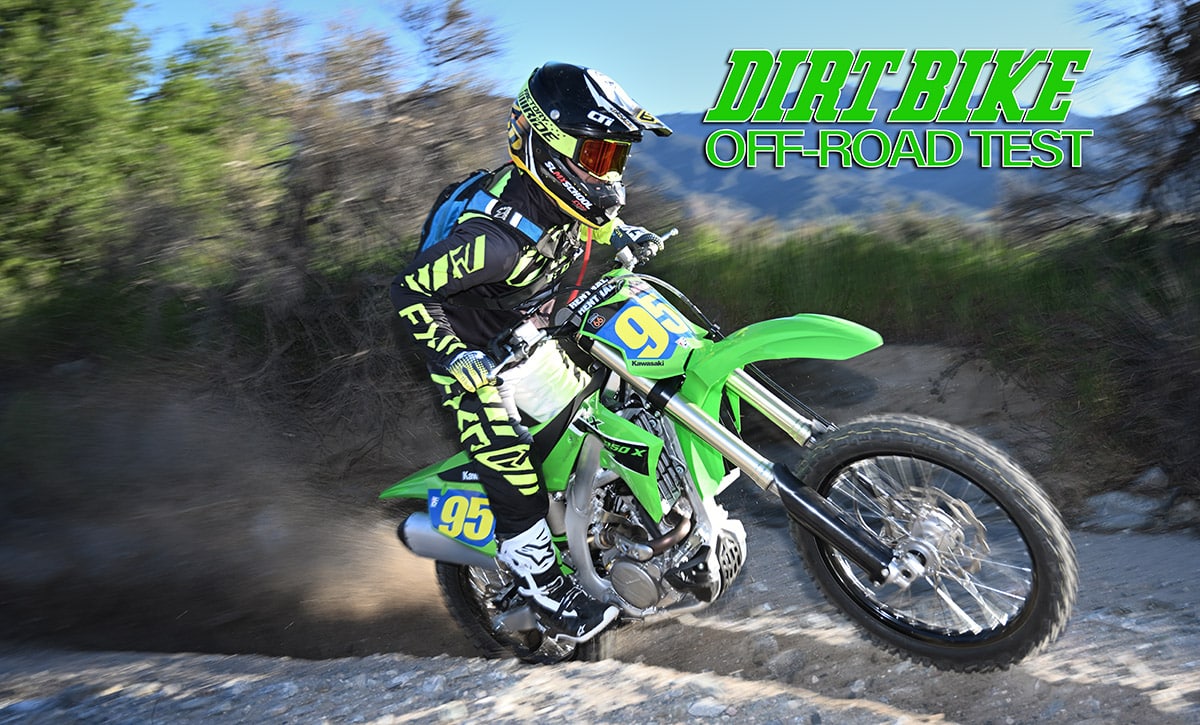Not long ago no one wanted to ride a 250 four-stroke off-road. Now, there’s a whole generation who wouldn’t dream of riding anything else, and bikes like the Kawasaki KX250X are the reason why. The 2023 version of the KX is fast, light and well mannered. Conversely, the 250Fs we were riding 10 years ago were heavy, slow, hard to start and easy to stop.
That’s not surprising considering the tidal wave of technology that has swept through the motorcycle industry, but the KX250X is exceptional by any standard. It’s the most powerful 250cc four-stroke that Japan has ever produced—aside, perhaps, from the motocross version of the same bike. Where the X really excels is that it takes all the latest motocross technology and seamlessly applies it to off-road riding and racing. The results are plain to see; Australian Lyndon Snodgrass won four rounds of the GNCC XC-2 class on his way to the 2022 Championship, routinely finishing in the top-five overall on the KX250X.

SHORT HISTORY, LONG LEGACY
The KX250X has only been around since 2021. Kawasaki, in fact, has never had off-road competition bikes despite a long history in off-road racing. The raw material for almost all off-road racers starts with a motocross bike, and the pre-2021 KX250 motocrosser would have been a square peg in the round hole of off-road racing, anyway. It was a kickstart-only bike with a weak clutch and poor low-end power. All that changed when the KX250 motocross bike was completely redesigned with electric start, a hydraulic clutch and the new chassis that was introduced on the 2019 KX450. That made an “X” version of the bike easy and natural.
For 2023, the KX250X has its first real update in its short history. Most of the changes are internal, starting with the head and intake. It now has smaller valves, which are set at a different pitch, plus the intake duct is straighter and the upstream injector was relocated from the top to the bottom of the air intake. On top of that, the flywheel rotor is heavier and the head pipe is longer. In the gearbox, first and second gear ratios are taller, so the bike is set up to go faster and shift later in each of those gears.
That 5-speed gearbox, by the way, is identical to the one in the motocross model. So is pretty much everything else as far as horsepower goes, from the pipe to the mapping. Kawasaki delivers the bike with the “black” coupler installed in the ignition. Like the motocross bike, the X has three maps preprogrammed into the ECU. You access those maps by installing any one of the three color-coded couplers—the black one is the richest and provides the smoothest power delivery. The only chassis differences that set it off as an off-road bike are suspension set-up, an 18-inch rear wheel, Dunlop AT81 tires and a kickstand. No additional fuel capacity, no handguards, no skid plate. The good news is that the KX is by nature a good starting point for an off-road racer. This is the only Japanese 250 that comes with hydraulic clutch actuation, and the clutch itself uses a coned disc instead of coil springs. This design increases clamping pressure on the plates without increasing lever pull, particularly as the lever gets closer to the grip.

ROCK AND REV
One of the reasons that 250 four-strokes have been embraced by the off-road world is because the power delivery is so well suited for trail riding. The usable rpm range is actually much wider for a modern 250 than it is for a 450. You can ride the KX250X down around 7000 rpm, and it will still pull itself out of almost any situation. And, when you’re really in a hurry, it can be revved to almost 14,000 rpm. If you try to ride a 450 like that, you’re in danger of stalling in the lower ranges and then having your arms ripped out of their sockets up high.
The KX250X still has a pretty big hit of its own. This year it gained power everywhere. According to the dyno, it has about a 1-horsepower increase in peak power, but that doesn’t really tell the whole story. Down around 8000 rpm, the new bike has a 3-horsepower increase, and that’s especially good news for off-road riding. On a motocross track, you rarely dip into that range, whereas off-road guys virtually live in that zone. Beyond the increase in power, the KX has excellent partial-throttle response. This manifests itself as a certain “willingness” to go. Other 250 four-strokes have a reputation for not really waking up until the throttle is wide open. Even if the Kawasaki is below its prime operating zone, it can be brought to life with a quick hit on the clutch. Our only real criticism of the power delivery is that it has a certain raspiness. It pops on decel and isn’t above the occasional flame-out. It’s a racer by nature and runs like one.
Kawasaki’s testing department did an excellent job adapting motocross suspension for off-road. It’s noticeably softer than the MX version. This year, that’s especially welcome. In our 2023 250 motocross comparison, most test riders found the KX was a little stiff, especially in front. It’s entirely possible that the KX250X would have done better in that comparison thanks to its softer setup. The X still is stiff for real trail riding. At speeds lower than 15 mph on trails that are littered with rocks of various sizes and shapes, the Kawasaki tends to roll around on top of all the chaos rather than suck it up. The Kawasaki can be a little hyperactive in both suspension compliance and overall handling. Again, this is a reminder that the X is more of a race bike than a trail cruiser.

FINISHING THE JOB
There are two different types of riders who will be drawn to the KX250X. One is a part-time motocrosser who wants all the performance of the MX version but with softer suspension. He might even like the kickstand and the 18-inch rear wheel for the weekend when there’s no racing. For that guy, the bike is ready to go as is. The other candidate for X ownership is the real off-road rider who understands how much potential it has. He will want to finish the job that Kawasaki started. We raced our 2022 KX250X test bike at various off-road events and found that the single-most worthwhile modification was a steering damper. That’s not news to anyone who races out west where the speeds are pretty fast, but the damper is also a great benefit for helping the bike go straight in rocky, slower sections. Obviously, handguards, a skid plate and a larger fuel tank will also be on the list. It makes you wonder why Kawasaki didn’t do more in the first place. But, you gotta consider the backstory. In the past, Kawasaki was always happy to promote its motocross bikes as off-road racers—Ty Davis, Larry Roeseler and a long list of other famous racers won a lot of off-road events with full factory support in the days when the company didn’t sell a bike for that. Given that history, we’re happy to have the KX250X in the off-road world. It was long overdue.



Comments are closed.